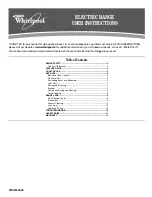
52
oven door lock will begin to close automatically
and once the door has been locked the “
DOOR
LOCKED
” indicator light will quit flashing and
remain on . Also the oven icon will show in the
display.
NOTE:
It takes about 15 seconds for the oven door
lock to close.
When the self-clean cycle is completed:
1.
Only the time of day and the “
DOOR LOCKED
”
icon will remain in the display.
2.
Once the oven has cooled down for approximately
1 HOUR, and the word “
DOOR LOCKED
” shown
in the display has gone out, the oven door can then
be carefully opened.
Stopping or interrupting a self-cleaning cycle:
If it becomes necessary to stop or interrupt a self-clean-
ing cycle due to excessive smoke or fire in the oven:
1.
Press
Clear Off
.
2.
Once the oven has cooled down for approximately
1 HOUR and the “
DOOR LOCKED
” icon is no
longer displayed, then the oven door may be
carefully opened.
How
the ES 400 operates:
CAUTION: NEVER ATTEMPT TO REMOVE EITHER
THE BAKE OR BROIL ELEMENT WITHOUT
DISCONNECTING ELECTRICAL POWER FROM THE
RANGE. ELECTRICAL POWER IS CONNECTED TO
THE ELEMENTS WHENEVER ELECTRICAL POWER
IS CONNECTED TO THE RANGE.
The ES 400 electronic oven control system is made up
of three parts that control the bake and broil elements,
and the locking of the door in clean.
1.
Electronic oven control.
2.
Oven temperature sensor.
3.
Oven door lock mechanism.
Preheat:
When the preheat pad is touched and a temperature is
entered with the number pads, the bake relay on the
board closes, and connects one side of the line to the
bake element. “PRE” and “BAKE” appear in the display.
After the first cycle “PRE” disappears and the oven
operates as in normal bake.
Bake:
When the bake pad is touched, and a temperature is
entered with the number pads, the bake relay on the
board closes, and connects one side of the line to the
bake element. “BAKE” appears in the display. In the tip
of the oven sensor is a positive thermistor that increases
in resistance as the oven temperature increases. The
EOC microprocessor reads the resistance of the oven
sensor, and compares it with the programmed temperature
set into the control. When the resistance of the oven
sensor indicates temperature in the oven is about 10
degrees above the programmed temperature, the
microprocessor opens the relay, which removes power
from one side of the element. When power is removed
from the element the oven temperature begins to lower.
As the oven temperature lowers the resistance of the
oven sensor decreases. When the oven drops to about
10 degrees below the programmed temperature, the
resistance of the sensor tells the microprocessor to
close the relay contacts, and once again provide power
to the element. After the first cycle and whenever the
oven calls for heat, the EOC cycles the broil element on
for seven seconds and then the bake element on for fifty
three seconds out of every minute. This provides top heat
during the bake cycle. The two elements are never on at
the same time.
NOTE: Oven controls may have a temperature
swing of more or less than 20 degrees. The
important thing is the average temperature in the
oven. The average temperature in the center of the
oven should be within 10 degrees of the
programmed temperature.
Time bake:
The time bake function allows the oven to be programmed
to stop bake at a set time, or to delay the start and stop
baking at a set time. The stop time cannot be set for
more than 11 hours and 59 minutes ahead of the time of
day.
Convection bake:
When the convection bake pad is touched and a
temperature is set, two things happen that do not happen
in normal bake. The EOC automatically raises the oven
temperature 15° F above the temperature that was
manually set in the control. If the oven door is closed, the
convection relay on the EOC closes, providing line to
neutral voltage to the convection fan motor and the
convection assist element. This relay remains closed
until the program is canceled or is interrupted by the
opening of the oven door. If interrupted by the opening of
the oven door, the relay will automatically close when the
door is closed.
Summary of Contents for NEXT GEN
Page 30: ...30 SAMPLE SCHEMATIC FOR ES100 CONTROL SYSTEM ...
Page 37: ...37 SAMPLE SCHEMATIC FOR THE ES 200 CONTROL SYSTEM ...
Page 46: ...46 SAMPLE SCHEMATIC FOR THE ES 300 CONTROL SYSTEM ...
Page 56: ...56 SAMPLE SCHEMATIC FOR THE ES 400 CONTROL SYSTEM ...
Page 66: ...66 SAMPLE SCHEMATIC FOR THE ES 450 CONTROL SYSTEM ...
Page 87: ...87 NOTES ...
Page 88: ...88 ...
















































